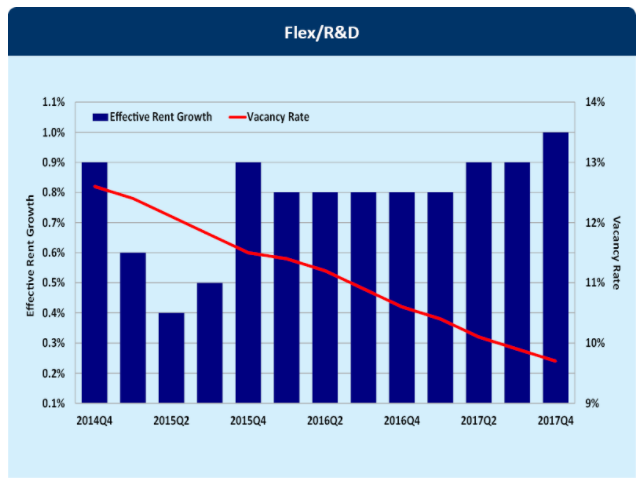Commercial Construction Is Still Risk-On
This year is expected to be another impressive year of growth in commercial construction. National Real Estate Investor recently reported: “Speculative office construction—as a percentage of supply underway—is expected to be at the highest level it has been in years in 2018, according to commercial real estate data firm CoStar.”
While vacancy rates have remained stable in traditional office buildings at around 16.5%, warehouse and flex-space has been in high demand. The chart below shows how flexible/R&D office space vacancies have steadily fallen to below 10%. Warehouse space vacancy, thanks to e-commerce, is even lower at 8.9%, generating growth in rents (second chart below).

Source: Warehouse space vacancy

Source: Warehouse space vacancy
Low vacancies and higher rents are expected to drive investment in new construction, and the American Institute of Architects (“AIA”) believes that the pace of construction activity will accelerate through 2019. The commercial/industrial construction sector is expected to lead the way in 2018 with 4.4% growth, “while industrial (+5.2%) and education-related projects (+4.9%) will be 2019’s top performers.”
The AIA produces a monthly report updating a variety of leading indices, and providing insight into the non-residential construction industry. Their most recent report in February indicated that architecture firms had seen their 5th consecutive month of rising billings, and were seeing continued positive momentum in inquiries and contracts.
Additionally, AIA’s chief economist noted a few tailwinds for the non-residential construction industry: “Rebuilding after the record-breaking losses from natural disasters last year, the recently enacted tax reform bill, and the prospects of an infrastructure package are expected to provide opportunities for even more robust levels of activity within the industry,” said AIA Chief Economist, Kermit Baker, PhD, Hon. AIA. “The Architecture Billings Index (ABI) and other major leading indicators for the industry also point to an upturn in construction activity over the coming year.”
Prefab Is the Future
Two of the major trends in commercial construction right now are utilizing prefabricated construction and being green. An AIA survey on the top design trends over the next decade pointed to offsite construction as the number one response.











Leave A Comment